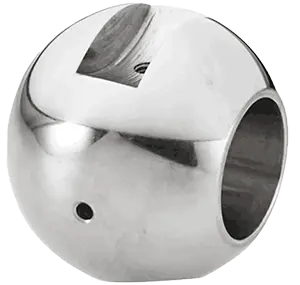преимущества шаровых клапанов с балансировавшими отверстиями
Oct 12, 2024
On this page
Compared to standard ball valves, ball valves with balance holes feature a unique internal structure design. The most significant distinction is the presence of a small hole, known as the balance hole, located on the ball itself. This balance hole connects to the pipeline's pressure and links to the valve's outlet side, aiming to reduce the pressure differential across the ball when the valve closes. This design helps prevent difficulties in closing the ball valve due to excessive medium pressure.
The operating principle of ball valves with balance holes is more complex than that of standard ball valves. When the valve needs to be closed, the medium's pressure is evenly applied to both sides of the ball through the balance hole, creating a balancing effect that significantly reduces pressure differential. This design effectively diminishes the fluid pressure acting on the valve core, allowing for easier operation even in high-pressure environments.
During the valve opening process, the balance hole also helps mitigate the impact force generated as the medium passes through the valve. This impact force occurs when the fluid rapidly changes direction and can easily damage the valve, reducing its lifespan. The design of the balance hole allows for the smooth dispersion of impact forces, thus protecting the valve structure and extending its service life.
Additionally, the existence of the balance hole tends to equalize the pressure on both sides of the valve core. This pressure balance enhances the valve's operating sensitivity and reduces friction during opening and closing, resulting in a smoother overall operation. As the fluid passes through the valve, the balance hole effectively lowers the pressure differential acting on the valve core, thus minimizing resistance and wear during operation.

Ball valves with balance holes offer significant tuning capabilities in terms of performance. By adjusting the size and number of balance holes, the performance of the ball valve can be further optimized. Increasing the size of the balance hole can enhance the valve's sensitivity, allowing it to respond more quickly to changes in fluid flow. Conversely, reducing the number of balance holes can improve the valve's sealing performance and decrease leakage rates. By carefully designing the parameters of the balance holes, ball valves can adapt to various working conditions, providing ideal control effects in high-temperature, high-pressure, low-temperature, and low-pressure environments.
Moreover, in high-demand applications such as chemical production lines and petroleum refining processes, ball valves with balance holes can be integrated with automated control systems for remote monitoring and adjustments, thus enhancing system intelligence and safety.
Ball valves with balance holes offer numerous significant advantages over standard ball valves.
Prevention of Closing Difficulties: In high-pressure environments, the design of the balance hole effectively prevents closing difficulties due to excessive pressure, ensuring system stability.
Extended Service Life: The balance hole reduces the fluid impact force, minimizing valve wear and increasing longevity.
Flexible Operation: Ball valves with balance holes operate more smoothly, making them ideal for applications requiring frequent opening and closing, effectively reducing operator fatigue.
Enhanced Safety: The design of the balance hole increases the valve's reliability and safety when handling high-pressure and corrosive media, reducing the risk of leaks.
Convenient Maintenance: Compared to other valve types, the simple structure of ball valves with balance holes makes maintenance and cleaning relatively easy, reducing costs and time.
Ball valves with balance holes are particularly suited for high-pressure applications, especially when dealing with media containing solid particles or corrosive substances. They are widely used in industries such as chemicals, petroleum, and metallurgy. In the chemical industry, these valves are commonly employed for precise control of fluid flow, such as in reaction vessels and raw material input. In the oil and gas sector, the valves can withstand high-pressure operations, ensuring the safety and stability of fluid transport.
Additionally, due to their simple structure and easy operation, ball valves with balance holes are suitable for general fluid control systems and find extensive applications in water treatment, heating, cooling, and firefighting systems.
When selecting a ball valve with balance holes, several factors should be considered.
Medium Characteristics: Chemical properties, state (gas or liquid), and the presence of solid particles in the fluid.
Working Pressure and Temperature: Ensure that the ball valve can operate stably within the expected pressure and temperature range.
Installation Environment: Choose appropriate valve body and sealing materials based on the site environment to enhance durability and adaptability.
Flow Requirements: Select the appropriate valve size and flow capacity to ensure efficient fluid control.
Regarding maintenance, it is essential to regularly clean the balance holes to prevent blockages and ensure unobstructed flow. Additionally, checking the valve's sealing performance and operational flexibility is crucial. Lubrication and adjustments should be made as necessary to ensure stable valve operation.
Ball valves with balance holes, with their unique design and flexible operational capabilities, have become efficient and reliable fluid control devices in industrial applications. Their ability to maintain excellent performance under complex working conditions secures their significant role in modern industrial systems. Through proper selection and maintenance, the advantages of ball valves with balance holes in fluid control can be fully realized, ensuring efficient and safe system operation.
Cледующий: подробная процедура испытания давления клапана
Предыдущий: проблемы и решения работы пневматического шарового клапана
О нас
Продукция
Навигация
Our Contacts
Building 2, NO.59, Songshan Road, SND, Suzhou, China
